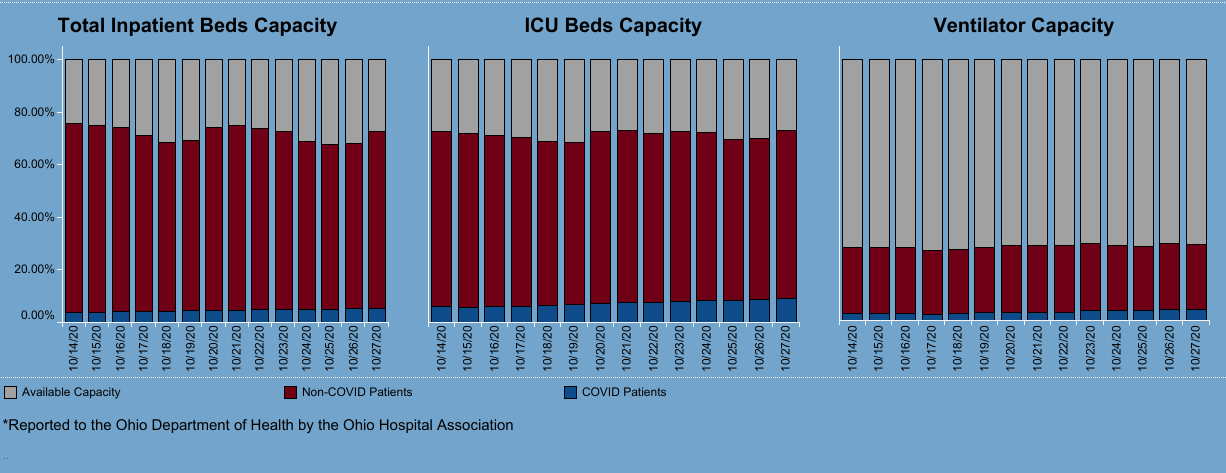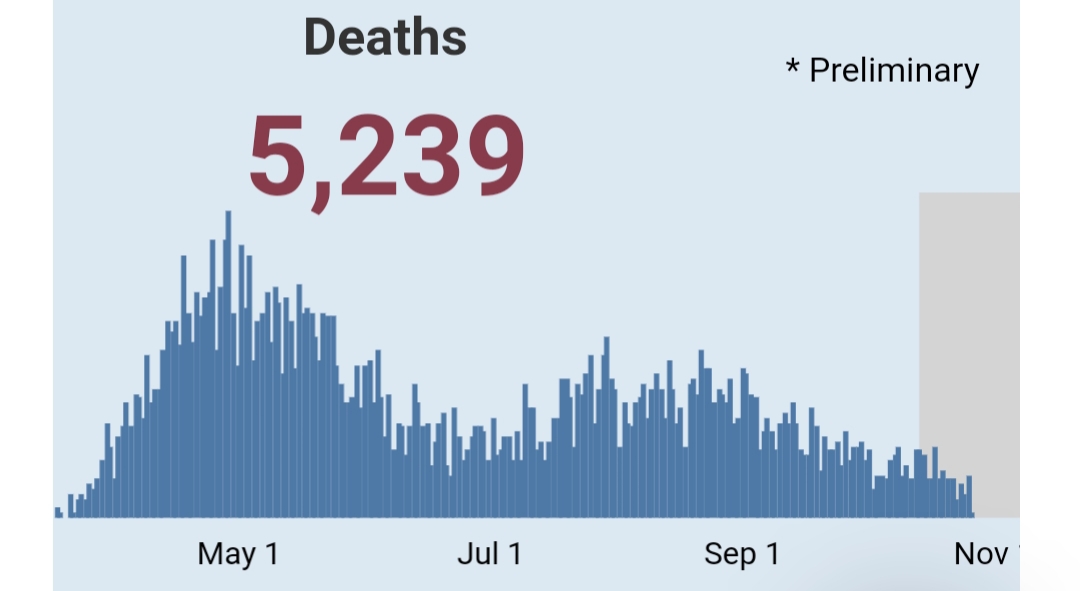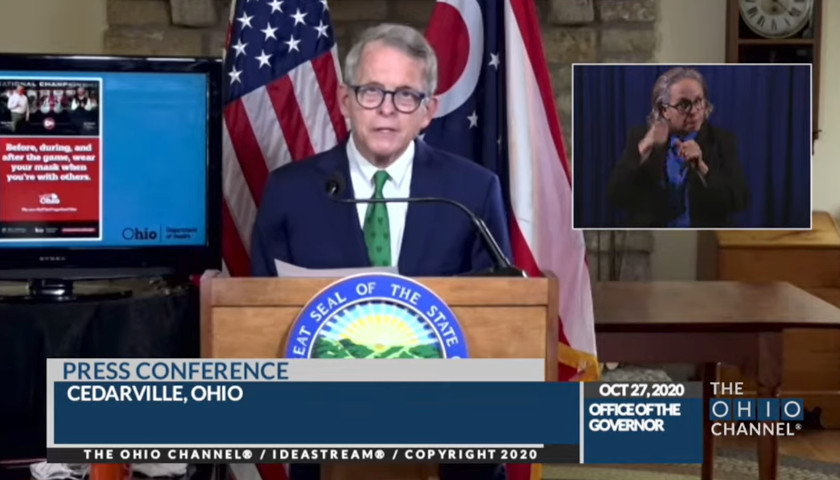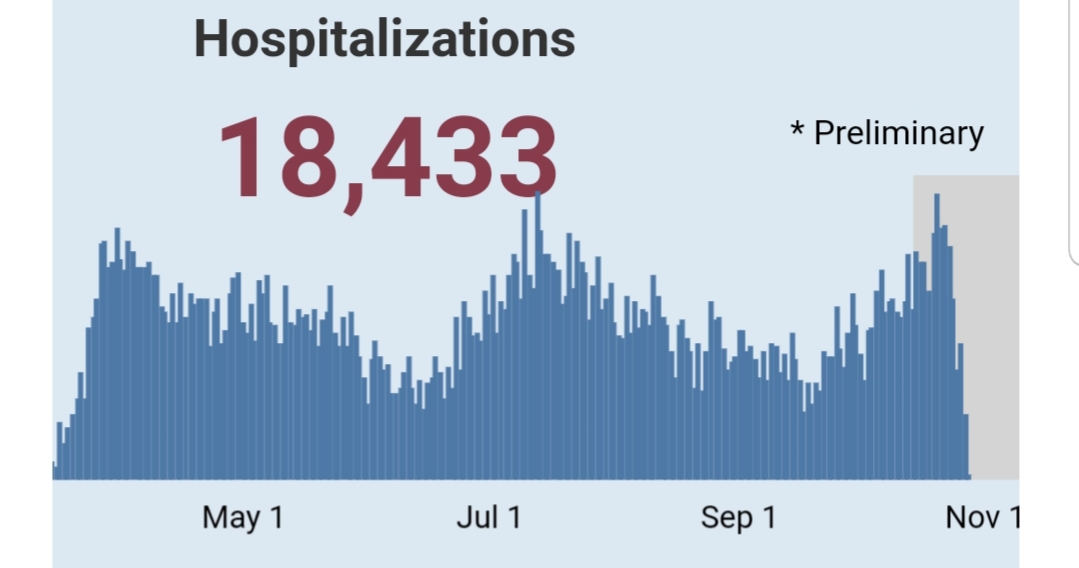COLUMBUS, Ohio – Governor Mike DeWine said on Tuesday that “all Ohioans should be alarmed” with the trajectory of the state’s COVID numbers.
DeWine reported 2,509 cases, 198 hospitalizations, 20 ICU visits and 22 deaths.
However, reported numbers are always higher than the actual numbers for the day – reported numbers can go as far back as the beginning of the epidemic.
This is best exemplified by one of Tuesday’s cases coming from January 22, according to the .csv file found on the state COVID site.
DeWine said that lives are at stake and that he also worries about hospitals starting to fill up – claiming hospitalizations are at the highest point since the state started intervening with public health measures.
Hospitalizations by onset date peaked on July 12 – although preliminary numbers from late October look to be contesting the July numbers, the numbers are “preliminary” and will decrease as they go into the official count column (preliminary “reported” hospitalizations are in gray in the graph, official hospitalizations by onset date are in blue).
Per the state key metrics page, inpatient bed capacity is at 70.8% – with 3.8% of beds with COVID patients. Total ICU bed occupancy is 64%, with 9% COVID patients. Ventilators utilized represent 25% of the state’s total capacity with 4.2% used by COVID patients.

Deaths peaked on April 28 at 64 and have not come close to the high point since.
Deaths by date of death (per the .csv file) over the past five days are as follows:
- October 26: 6
- October 25: 11
- October 24: 6
- October 23: 11
- October 21: 16
- October 20: 15

Ohio does not deviate from the CDC definition of a COVID death, which makes no distinction between a death from COVID and a death from something else but COVID or “suspected COVID” present on the death certificate.
Ohio is reporting a total of 202,740 cases (191,069 confirmed and 11,671 probable) and 5,239 total deaths (4,927 confirmed and 312 probable). Between October 20 – 25 Ohio has tested an average of 42,836 people a day.
The state estimates that 161,704 people have recovered. There are 35,797 active cases in Ohio – 0.003 percent of Ohio’s 11.68 million people.
DeWine said that he would schedule zoom calls with community leaders in each of Ohio’s high incidence counties – 82 of 88 counties. High incidence is a term used by the CDC for areas that have greater than 100 positive cases per 100,000 people.
The Star recently reported that the federal government-supplied BinaxNOW tests the state is using in schools, nursing homes and other places are antigen tests – the same type of test that returned a false positive for DeWine.
Additionally, the U.S. Food and Drug Administration (FDA) granted emergency use authorization for the tests but with several requirements – one being test takers have their health histories considered in order to limit false positives and negatives. BinaxNOW tests can detect non-contagious COVID, bacterial infections and other viruses.
However, unlike the governor, NFL players or college football coaches, average Ohioans are not routinely administered second tests to undo any false test the first time.
Consequently, a high school golfer and football teams were denied the chance to compete despite being healthy.
In fact, one anecdotal report The Star received from the parent of an Ohio high school student told the story of how the high schooler was forced to quarantine but opted to take a COVID test that returned negative. However, the student was told the negative test would not eliminate the order to be locked down.
The Star sent an email to The Ohio Department of Health (ODH) inquiring about whether the steps the U.S. Food and Drug Administration requires the state to follow are being adhered to.
ODH Press Secretary Melanie Amato responded: “There were multiple communications from the federal govt. to the facilities that received both the POC [point of care] machines as well as the Binex cards [BinaxNOW tests], including instruction on use, requirements, as well as resupply.”
Local health departments are charged with following the FDA guidelines. It is not clear if there is a state-level audit on local departments to ensure compliance.
The next COVID briefing is scheduled for Thursday at 2:00 p.m. EST.
– – –
Jack Windsor is Managing Editor and an Investigative Reporter at The Ohio Star. Windsor is also an Investigative Reporter at WMFD-TV. Follow Jack on Twitter. Email tips to [email protected].
Photo “Mike DeWine” by The Ohio Channel.







